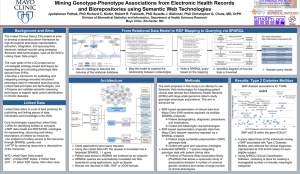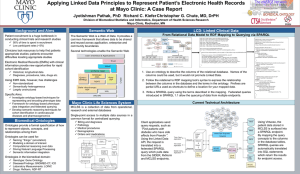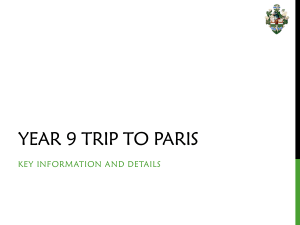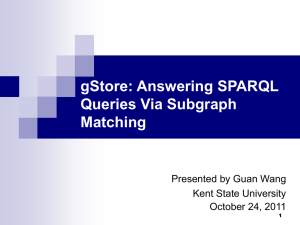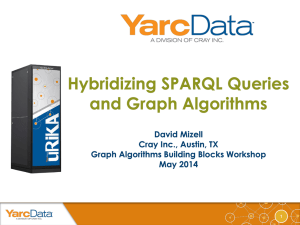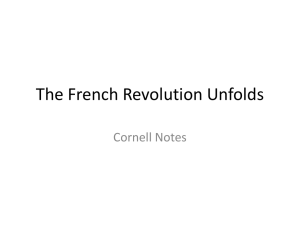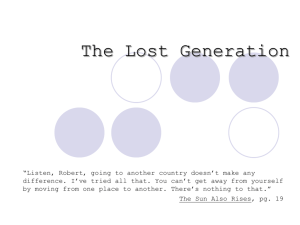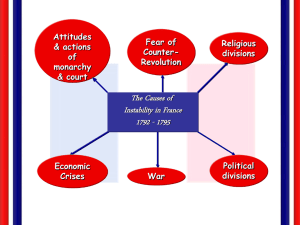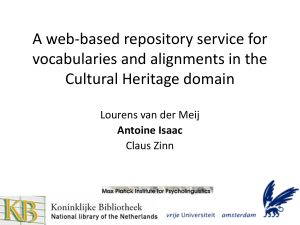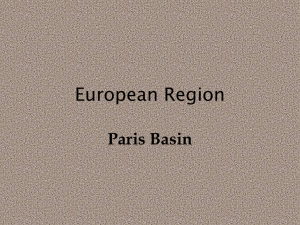Linked Data : Exposing your data on the Web
advertisement
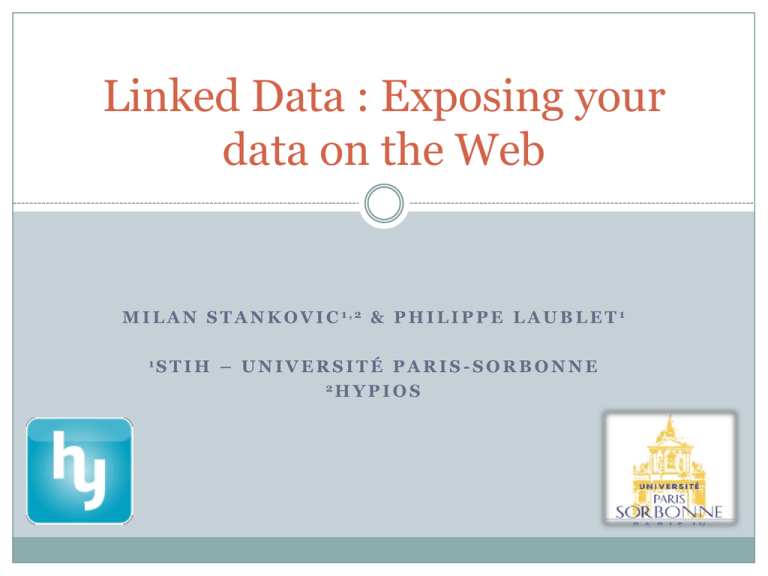
Linked Data : Exposing your data on the Web M I L A N S T A N K O V I C 1,2 & P H I L I P P E L A U B L E T 1 1S T I H – UNIVERSITÉ PARIS-SORBONNE 2H Y P I O S Outline Basic Notions What is Linked Data Basic instruments for publishing data (RDF, OWL,…) What are the objectives of publishing structured data on the Web How do we publish Data on the Web RDF files & SPARQL Endpoints Collaboration in the Knowledge Community Web 2.0 Collaborative Tools SemSLATES methodology Basic Notions Linked Open Data : a social and technical phenomenon More and more data becoming openly available government data, cultural content,… Important to make data accessible to machines facilitates data exchange between heterogeneous systems enables the growth of services and applications based on public data enables alternative ways to visualize and navigate through data The quantity of available public Linked Data is doubling every year (since 2007) Data is Published in Graphs hasTitle hasCreationDate Linked Data : Exposing your data on the Web 08/02/2011 myPresentation hasName hasAuthor me livesIn livesIn Karl Lagerfeld Milan Paris Ontologies Define the Meaning of Data hasAuthor Presentation livesIn Person hasTitle hasCreationDate City Linked Data : Exposing your data on the Web 08/02/2011 myPresentation hasName hasAuthor me livesIn Karl Lagerfeld livesIn Milan Paris Data Ontolgoies Ontologies, Data, Web Resources Document superclass hasAuthor Presentation myPresentation domain hasTitle hasCreationDate hasAuthor range Linked Data : Exposing your data on the Web 08/02/2011 me hasName livesIn livesIn Karl Lagerfeld Web resources Person Milan Paris Web of Pages -> Web of Data On the Web of Pages we put pages of content pages have URLs we link pages to other pages using hyperlinks On the Web of Data we put data directly online data objects have URIs higher granularity we link data objects to other objects defined elsewhere, using semantic relations we use ontologies to give meaning to data Basic Notions: URI URI: Uniform Resource Identifier uniquely identifies resources on the Web enables us to refer to a resource and interact with it URL, as a difference, allows to locate a resource. Not every URI is a URL http://www.wikipedia.org/ identifies a resource (Wikipedia's home page) and implies that a representation of that resource is obtainable via HTTP from a network host named www.wikipedia.org. Basic Notions: RDF Data is put on the Web using a formalism for describing Web Resources – RDF data comes in the form of triples (subject-predicate-object) ex: thisPresentation – hasAuthor - Milan hasTitle hasCreationDate myPresentation Linked Data : Exposing your data on the Web 08/02/2011 http://www.example.com/uris#myPresentation hasName hasAuthor me Milan http://www.example.com/uris#me livesIn Paris http://dbpedia.org/resource/Paris Basic Notions: Ontologies Ontologies provide a shared vocabulary meaning of classes and properties is well defined, which allows to « understand » the data in exchange Ontologies contain general knowledge, valid for all data instances they allow to infer additional facts from the available (scarce) data Ontology Web Language (OWL) is used to create them several versions of OWL exist, with different expressive power (the greater the expressive power, the lower the inference possibilities) Basic Notions: Motivations Some motivations for publishing Linked Data data reuse and exchange Independent development of application that add value to public data e.g. http://data.gov.uk application ecosystem The Public Linked Data Cloud today How to publish Linked Data Publishing Linked Data The simplest way is to provide RDF files for the same URI, we can provide RDF to machines, and normal Web pages to humans There is a way to hide RDF markup in Web pages RDFa standard, used by Google, Facebook,… Provide universal API – query Interfaces SPARQL is a query language for data graphs – similar to SQL it allows to select parts of the graph of our interest Publishing Linked Data: SPARQL Endpoints http://dbpedia.org/sparql Publishing Linked Data: SPARQL Endpoints It is possible to build graphic interfaces on top of SPARQL endpoints http://dbpedia.neofonie.de/browse/ easy to design faceted browsing Application that can work with one SPARQL endpoint can work with any other provided that the application userstands the ontologies used in the endpoint it is possible to discover new data sources using Sindice.com Linked Data in Collaborative Work THE SEM-SLATES APPROACH Collaborating on Web 2.0 Many Web 2.0 tools facilitate collaborative work Easy collaborative creation of content Commenting and other forms of interactions / feedback Collaborative annotation and content organization : tagging SLATES paradigm Search: text-based or tag-based Links Authoring (wikis,..) Tags (user based annotation) Extensions (suggestions of relevant content) Signals (RSS, notifications, etc..) Issues with SLATES systems Information fragmentation information about one object is fragmented in several places information exposed in various non-interoperable formats difficult to merge, integrate and get a global view knowledge modeling and reuse information exposed as plain text answering complex queries is difficult Tagging issues ambiguity (e.g., Paris – France, Paris Hilton) heterogenity (e.g., semanticWeb, semantic_web) no structure/hierarchy links between tags Solution: SemSLATES We generate Linked Data annotations for the content SLATES SEM SLATES search text-based based on data annotations links between pages between resources authoring documents data and metadata tags textual keywords semantic tagging (concepts) Extension hypertext navigation RDF graph-based navigation Signals RSS feeds Semantically-indexed RSS feeds hasTitle hasCreationDate Linked Data : Exposing your data on the Web 08/02/2011 myPresentation hasName hasAuthor me livesIn livesIn Karl Milan Paris Collaborative tools SemSLATES The User Generated Content is Automatically Annotated with Semantics throught software addons metadata about social interactions and resulting documents can be automatically added Addons exist for major content publishing systems Wordpress plugin exposes data using SIOC ontology Drupal Semantic Wikis, http://semantic-mediawiki.org/ En Example in Microblogging SMOB.me SemSLATES Although most annotations are produced automatically, some user input is needed for dissambiguation users might precisely choose concepts for tagging (Paris – France, or Paris Hilton) exisitng tools like Faviki, can facilitate this task SemSLATES : New Possibilities Answer complex search queries some examples Find all papers about Nietzsche, written by someone employed by a European institution Find people who created content about Picasso, who work in a European museum SPARQL queries over data give more precise results then simple keyword based searches Integrate content from several sources different institutions may use their own tools, as long as they publish the output data in a unified way, in accordance to chosen vocabularies SemSLATES : New Possibilities Possible to create mash-ups, adding data from other Linked Data sources geographical data is the most common example, Geonames.org Create Faceted Interfaces http://simile-widgets.org/exhibit/ How To Adopt SemSLATES Identify the content to annotate and expose as Linked Data Identify ontologies that may to used to describe data some ground already set by Europeana Data Model (EDM) Choose Collaborative Tools install appropriate add-ons, or adopt semantic versions of collaborative software if needed develop addons and adapt existing tools to use the chosen ontologies Design Interfaces on top of data Create Data – Use the Tools Questions mail@milstan.net
